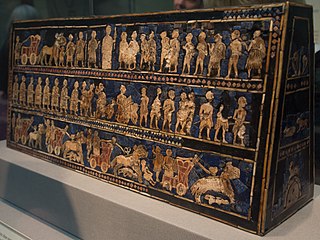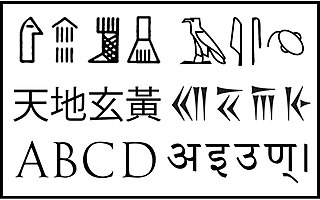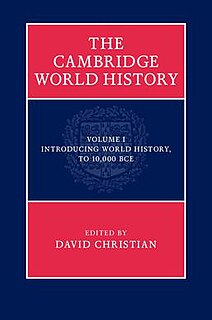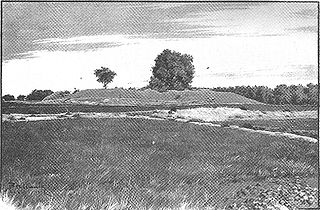Related Research Articles

Mehrgarh is a Neolithic archaeological site situated on the Kacchi Plain of Balochistan in Pakistan. It is located near the Bolan Pass, to the west of the Indus River and between the modern-day Pakistani cities of Quetta, Kalat and Sibi. The site was discovered in 1974 by an archaeological team led by the French archaeologists Jean-François Jarrige and his wife, Catherine Jarrige. Mehrgarh was excavated continuously between 1974 and 1986, and again from 1997 to 2000. Archaeological material has been found in six mounds, and about 32,000 artifacts have been collected from the site. The earliest settlement at Mehrgarh—located in the northeast corner of the 495-acre (2.00 km2) site—was a small farming village dated between 7000 BCE and 5500 BCE.

Ancient history is the aggregate of past events from the beginning of writing and recorded human history and extending as far as late antiquity. The span of recorded history is roughly 5,000 years, beginning with the Sumerian cuneiform script. Ancient history covers all continents inhabited by humans in the period 3000 BCE – 500 CE. The three-age system periodizes ancient history into the Stone Age, the Bronze Age, and the Iron Age, with recorded history generally considered to begin with the Bronze Age. The start and end of the three ages varies between world regions. In many regions the Bronze Age is generally considered to begin a few centuries prior to 3000 BCE, while the end of the Iron Age varies from the early first millennium BCE in some regions to the late first millennium CE in others.

The following outline is provided as an overview of and topical guide to ancient India:
A chiefdom is a form of hierarchical political organization in non-industrial societies usually based on kinship, and in which formal leadership is monopolized by the legitimate senior members of select families or 'houses'. These elites form a political-ideological aristocracy relative to the general group.

The history of science and technology in the Indian subcontinent begins with the prehistoric human activity of the Indus Valley Civilization to the early Indian states and empires.

The Northern Black Polished Ware culture is an urban Iron Age Indian culture of the Indian Subcontinent, lasting c. 700–200 BCE, succeeding the Painted Grey Ware culture and Black and red ware culture. It developed beginning around 700 BCE, in the late Vedic period, and peaked from c. 500–300 BCE, coinciding with the emergence of 16 great states or mahajanapadas in Northern India, and the subsequent rise of the Mauryan Empire.

The history of writing traces the development of expressing language by systems of markings.
George L. Cowgill was an American anthropologist and archaeologist. He was a professor of anthropology at Arizona State University from 1990-2005, and research professor emeritus from 2005 until his death. He received his PhD from Harvard in 1963 with a dissertation on The Post-Classic Period in the Southern Maya Lowlands. Most of his career was devoted to research at the ancient Mexican city of Teotihuacán. He taught at Brandeis University between 1960 and 1990. Cowgill made important contributions in a number of areas, including the archaeology of Mesoamerica, the comparative study of early states and cities, and quantitative methods in archaeology.

A stateless society is a society that is not governed by a state. In stateless societies, there is little concentration of authority; most positions of authority that do exist are very limited in power and are generally not permanently held positions; and social bodies that resolve disputes through predefined rules tend to be small. Stateless societies are highly variable in economic organization and cultural practices.
Several periodisations are employed for the periodisation of the Indus Valley Civilisation. While the Indus Valley Civilisation was divided into Early, Mature and Late Harappan by archaeologists like Mortimer Wheeler, newer periodisations include the Neolithic early farming settlements, and use a stage–phase model, often combining terminology from various systems.
This article lists historical urban community sizes based on the estimated populations of selected human settlements from 7000 BC – AD 1875, organized by archaeological periods.

Pottery in the Indian subcontinent has an ancient history and is one of the most tangible and iconic elements of Indian art. Evidence of pottery has been found in the early settlements of Lahuradewa and later the Indus Valley civilization. Today, it is a cultural art that is still practiced extensively in Indian subcontinent. Until recent times all Indian pottery has been earthenware, including terracotta.

The origins of Judaism lie in the Bronze Age amidst polytheistic ancient Semitic religions, specifically evolving out of the polytheistic ancient Canaanite religion, then co-existing with Babylonian religion, and syncretizing elements of Babylonian belief into the worship of Yahweh as reflected in the early prophetic books of the Hebrew Bible.
Choga Mami is a Samarran settlement site in Diyala province in Eastern Iraq in the Mandali region. It shows the first canal irrigation in operation at about 6000 BCE.

Pakistan is home to many archaeological sites dating from Lower Paleolithic period to Mughal empire. The earliest known archaeological findings belong to the Soanian culture from the Soan Valley, near modern-day Islamabad. Soan Valley culture is considered as the best known Palaeolithic culture of Central Asia. Mehrgarh in Balochistan is one of the most important Neolithic sites dating from 7000 BCE to 2000 BCE. The Mehrgarh culture was amongst the first culture in the world to establish agriculture and livestock and live in villages. Mehrgarh civilization lasted for 5000 years till 2000 BCE after which people migrated to other areas, possibly Harappa and Mohenjo-daro. Harappa and Mohenjo-daro are the best known sites from the Indus Valley civilization.

Craig G. Benjamin is an Australian-American historian who is professor of history in the Frederik J. Meijer Honors College at Grand Valley State University, where he teaches East Asian civilization, big history, ancient Central Asian history, and world history historiography. In 2014 and 2015 he served as President of the World History Association.

The Cambridge World History is a seven volume history of the world in nine books published by Cambridge University Press in 2015. The editor in chief is Merry E. Wiesner-Hanks. The history takes a comparativist approach.

Shaji-ki-Dheri is the site of an ancient Kanishka stupa about 6 kilometers from Peshawar, Pakistan.

Yarim Tepe is an archaeological site of an early farming settlement that goes back to about 6000 BC. It is located in the Sinjar valley some 7km southwest from the town of Tal Afar in northern Iraq. The site consists of several hills reflecting the development of the Hassuna culture, and then of the Halaf and Ubaid cultures.
References
- ↑ Norman Yoffee. Institute for the Study of the Ancient World. Retrieved 20 February 2016.
- ↑ The Cambridge World History Volume 3: Early Cities in Comparative Perspective, 4000 BCE–1200 CE. Cambridge Histories Online. Retrieved 20 February 2016.
- ↑ Norman Yoffee - "Early Cities and the Evolution of History". FHSSVideos, YouTube, 7 August 2013. 1m.48s. Retrieved 20 February 2016.